|
Ultra-Accurate Hunter--Hawaiian Style
Maui Eric's Amazing "Pair of Jackals"-- 6BR Rifle-Handgun Combo
Other Guns of the Week >
Every once in a while a product comes along that is so innovative, so well thought-out, and so flawless in both design and execution that it alters the whole way we think about things. This radical 6BR combo rifle/pistol falls into that category--a brilliant design that sets new standards for quality, versatility and accuracy among hunting rifles. This ain't your grandad's deer rifle--but it may represent the future of ultra-accurate hunting guns.
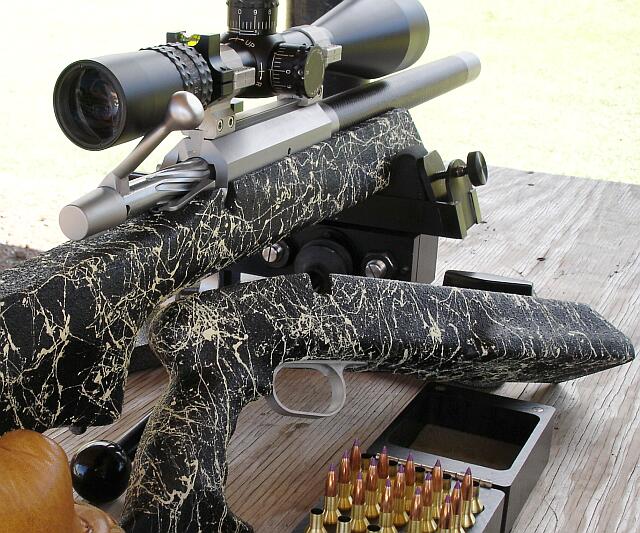
 The Ultimate 'Hunter Benchrest'--That Really Hunts! The Ultimate 'Hunter Benchrest'--That Really Hunts!
Eric tells us, "My goal with this project was to build a legal, all-weather combination rifle/pistol with Benchrest accuracy and first-shot reliability in the field. I also wanted a rig that could switch scopes with nearly no change in zero. I wanted a gun that could shoot in the Twos or better off the bench at 100 yards while being effective out to 300 yards on medium-sized game. This needed to be a compact, handy rig to hunt Axis deer and sheep in any terrain. I hunt here on Maui, Hawaii and also neighboring islands. Our hunting grounds range from sea level to 10,000 feet with temperatures varying from 30 degrees to nearly 100 degrees. In one hunt, I've gone from 80 degrees in lower elevations to slushy ice on the slope of a volcano, so you can see Hawaii can get interesting in the field. The photo at right was taken on the East end of Maui, high up in the hills on a recent wild boar hunt. If you've been to Maui, you know that rainbows are an everyday occurrence. Life's hard in paradise....
Barrel Specs -- Minimum Length for Maximum Utility
There are two barrels for my Jackals, both 14-twist with .268" necks. The first is a cryo-treated MTU-taper stainless Kreiger, crowned at 16". The black barrel is a 17" straight-taper Krieger, turned down and wrapped in carbon by Christensen Arms. Both Kriegers are awesome. Break-in took just 10 shots, using the recommended shoot-and-clean ritual. Now I clean every 25 shots or so, and I've seen no copper fouling. There is a bit of a story behind the carbon tube. I called Dwight Scott to see if he had any good 1:14" twist Krieger blanks in his shop. Dwight said he had a batch and so far these barrels from John were good barrels. He chambered a few for 6PPC and had great results, so of course, I wanted one. I told Dwight that what I was going to do was have it carbon wrapped by Christensen Arms. Dwight advised that the carbon wrap be done first so it wouldn't hamper his chambering and crown work.
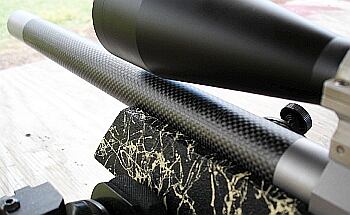 I called John Krieger and he confirmed that other customers had used carbon-wrapped Krieger blanks with success in Cross-the-Course rifles. John patiently listened to all my questions and explained many complex, technical matters in simple terms so I could understand. Based on that conversation alone, I will continue using his steel. I couldn't ask for better service (from the boss himself, no less!) So, with John's blessing, I called Dwight back and we moved forward. We went with a 1.250" straight taper, crowned at 17 inches. (In Hawaii a 16-inch is considered legal.) I had Dwight chamber it in a 6BR for Lapua brass with a .268" neck (ideal dimension for an easy, one-pass turn with full clean-up of the neck). Dwight called me a month later and said he received the blank and mentioned that Christensen's work was very good. Dwight did his magic and bead-blasted all exposed steel to match my action. Never having used a carbon-wrapped barrel before, I wondered "will it shoot?" Those fears turned out to be unfounded. The Krieger/Cartensen carbon barrel shoots in the Ones and Twos. I called John Krieger and he confirmed that other customers had used carbon-wrapped Krieger blanks with success in Cross-the-Course rifles. John patiently listened to all my questions and explained many complex, technical matters in simple terms so I could understand. Based on that conversation alone, I will continue using his steel. I couldn't ask for better service (from the boss himself, no less!) So, with John's blessing, I called Dwight back and we moved forward. We went with a 1.250" straight taper, crowned at 17 inches. (In Hawaii a 16-inch is considered legal.) I had Dwight chamber it in a 6BR for Lapua brass with a .268" neck (ideal dimension for an easy, one-pass turn with full clean-up of the neck). Dwight called me a month later and said he received the blank and mentioned that Christensen's work was very good. Dwight did his magic and bead-blasted all exposed steel to match my action. Never having used a carbon-wrapped barrel before, I wondered "will it shoot?" Those fears turned out to be unfounded. The Krieger/Cartensen carbon barrel shoots in the Ones and Twos.
BAT 7.5" Action--With a Few Extras
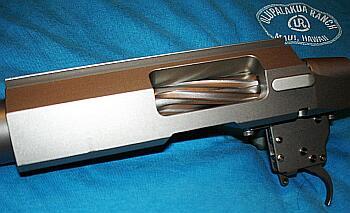 After speaking to several of the shooting world's "Top Guns", I decided that I could not go wrong with BAT in terms of quality and precision. Plus BAT could customize the action to my specs. I called Bruce Thom and he told me he could build what I wanted, a six-sided Multi-Flat (7.5"x1.5") with flat bottom, integral scope base, and two bolts. An undercut on the bottom of the action serves as a recoil lug. The scope rail is machined into the action like on a Kelby Panda, but of course it is stainless not aluminum. Two sets of Kelbly rings on two scopes top it off with a Jewell trigger set at 16 ounces. After speaking to several of the shooting world's "Top Guns", I decided that I could not go wrong with BAT in terms of quality and precision. Plus BAT could customize the action to my specs. I called Bruce Thom and he told me he could build what I wanted, a six-sided Multi-Flat (7.5"x1.5") with flat bottom, integral scope base, and two bolts. An undercut on the bottom of the action serves as a recoil lug. The scope rail is machined into the action like on a Kelby Panda, but of course it is stainless not aluminum. Two sets of Kelbly rings on two scopes top it off with a Jewell trigger set at 16 ounces.
The action is a work of art, and the custom features perform just as I had hoped. BAT milled the integral rail in such a way that the scope ring bases do not bind or mark the rail when installed. Chalk that up to some Bruce Thom wizardry. To swap optics, I simply loosen the rings' rail cross-bolts and carefully slide one scope off and replace it with the other scope with its own pair of Kelbly rings already attached. The rings tighten up solid with nearly no change in zero. When I change to my Nightforce from my Zeiss 6X scope I only need to dial in about 0.5" of vertical at 100 yards. And there is no horizontal shift when I switch scopes. Amazing! That tells me the difference in scope height explains the small shift in POI. It goes to show you how precise this action and rings are machined.
I also had Bruce make me two bolts for this action--one diamond fluted and one spiral fluted. The action and both bolts were bead blasted to match the Kelbly rings' finish. The workmanship on this action is truly remarkable. You have to cycle it to fully appreciate the quality. The bolt feels like it is sliding on glass. The tolerances are extremely close and there is absolutely no slop. There are many good custom actions out there and I have several and sold a few others that I have used. To me, this is the finest precision action I have seen or owned. BAT actions are not cheap, but you get what you pay for.
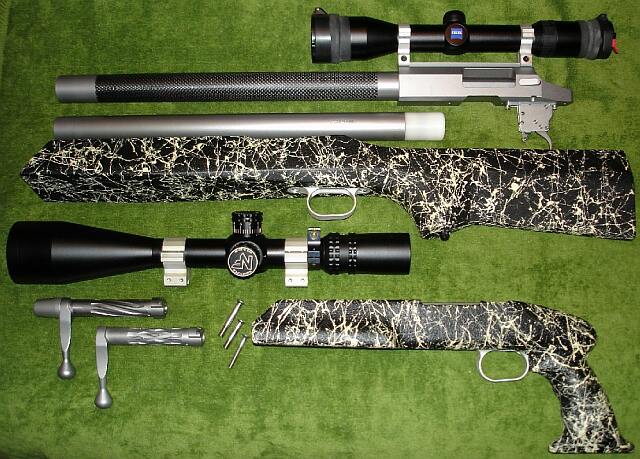
Twin Stocks for Twice the Fun
Pistol Stock: I started with a Bruno's solid-filled benchrest stock. I wanted the stock to balance in the center of the scope area so the gun would not tilt forward. I removed material from the fore-end (and reshaped it slightly) until it balanced with the fitted barrels. The gun balances well off the bags when firing off the bench and also off my pack when I am in prone or sitting in the field. The stock feels nice and stable and, being solid fiberglass, vibrations and torque are minimal. Tommy Meredith did the pillar bedding and I did the paint. It still has a little torque when fired off the bags with a loose hold, but I think that's because of the short fore-end. In the field, with a tighter grip, it feels right and besides, that is why I made it this way. My "Jackal" pistol is really compact when slung on my shoulder. I can even stow it in my backpack when I have a long trek to an area where I'll hunt. (Very sweet.)
Rifle Stock: I had an SG&Y coffin-style benchrest fiberglass stock that was lying around for a while. I did not want to ruin it by cutting it up at the front or back, so I called Wenig Custom Stocks and asked them to duplicate Speedy's stock in birch laminate. It came back identical, but being wood rather than glass, I could easily modify the front and rear of the stock using simple tools. I then had Bruce at BAT Machine inlet it for my action. From there, I sent my action and the stock to Tommy Meredith to pillar bed. As I did with the pistol stock, I took off material from the front and back to balance with barreled action attached. Then I did the sanding and paint work.
Load Development and Accuracy
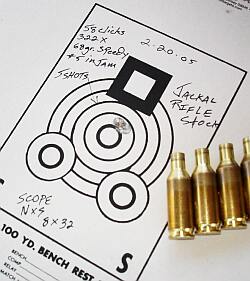 My range is at sea level with winds ranging from zero to 45 mph. The target in the photo was shot on a calm day with winds about 5 to 10mph. No flags were used, but I had a streamer tied on the target frame at 100 yards. (Using three Hensley flags, I have shot a few groups in the Zeroes on calm days.) My primary accuracy load uses 68gr Speedy bullets set .005" into the lands pushed by Hodgdon H322 Extreme with Federal match primers. The load is 58 clicks on a Harrell's measure and the powder comes right to the base of the case neck. Groups with this load run mid-Ones to low Twos consistently unless the mirage is bad, when they can open up to low Twos and Mid-Threes due to "driver error." My second favorite load is 58.2 clicks Vihtavuori N133 powder poured with a 3" drop tube. Same bullets (Speedy 68gr) and seating depth (.005" jam). This also averages in the mid-Ones to low Twos. For hunting, I also use Nosler 70gr Ballistic Tips. The Nosler 70s are effective and very accurate, averaging in the mid Twos at 100 yards. They drop deer and sheep quickly. I have never lost an animal using these bullets. My range is at sea level with winds ranging from zero to 45 mph. The target in the photo was shot on a calm day with winds about 5 to 10mph. No flags were used, but I had a streamer tied on the target frame at 100 yards. (Using three Hensley flags, I have shot a few groups in the Zeroes on calm days.) My primary accuracy load uses 68gr Speedy bullets set .005" into the lands pushed by Hodgdon H322 Extreme with Federal match primers. The load is 58 clicks on a Harrell's measure and the powder comes right to the base of the case neck. Groups with this load run mid-Ones to low Twos consistently unless the mirage is bad, when they can open up to low Twos and Mid-Threes due to "driver error." My second favorite load is 58.2 clicks Vihtavuori N133 powder poured with a 3" drop tube. Same bullets (Speedy 68gr) and seating depth (.005" jam). This also averages in the mid-Ones to low Twos. For hunting, I also use Nosler 70gr Ballistic Tips. The Nosler 70s are effective and very accurate, averaging in the mid Twos at 100 yards. They drop deer and sheep quickly. I have never lost an animal using these bullets. |
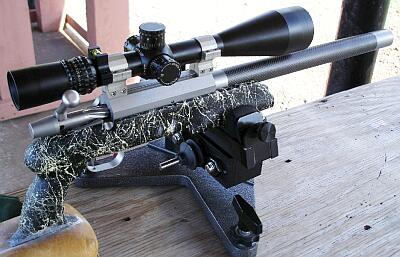 While I use the same loads for both rifle and pistol versions, I use a different technique for each rig. When shooting with the rifle stock on the bench, I use a free-recoil style. With the pistol I use a very light hold on the pistol grip with the trigger pull set at two ounces. With the pistol, you must use the same hold and tension for EVERY shot. If you don't, groups will suffer. My pistol shoots in the low Twos to mid-Threes. If I do everything right, I can Agg in the low Twos. When I hunt I adjust my trigger back to one pound. Let me assure you, a two-ounce trigger is not what you want in the field--I know from experience. While I use the same loads for both rifle and pistol versions, I use a different technique for each rig. When shooting with the rifle stock on the bench, I use a free-recoil style. With the pistol I use a very light hold on the pistol grip with the trigger pull set at two ounces. With the pistol, you must use the same hold and tension for EVERY shot. If you don't, groups will suffer. My pistol shoots in the low Twos to mid-Threes. If I do everything right, I can Agg in the low Twos. When I hunt I adjust my trigger back to one pound. Let me assure you, a two-ounce trigger is not what you want in the field--I know from experience.
Optics for Hunting and Benchrest
I use two scopes for this rig. For most of my hunting, I use a German-made 1.5-6x40mm Zeiss, with 30mm tube, quarter-MOA clicks and a thick outer to fine center Z-plex reticle. A prime example of European engineering, the Zeiss is bright, rugged, and very, very sharp. Hard to beat Zeiss glass for a hunting optic. My second scope is a Nightforce NXS 8-32x50mm with the NP-R2 reticle. This scope has a side-focus (parallax adjustment knob) on the left side turret that also turns on the lighted reticle for low-light or night shooting. The Nightforce's reticle is laser-etched into the glass (most scopes have wire reticles). Etched reticles are ideal for illuminated optics, and the absence of wires is one less mechanical thing to worry about. Like the Zeiss, my Nightforce features quarter-MOA clicks and a 30mm tube. I use the big NXS for tuning my loads on the bench and when I know shots will be on the long side. I've tried many different scopes in the past and I can say these are the finest optics I have ever used. Big bucks, yes, but each is the best for its intended purpose.
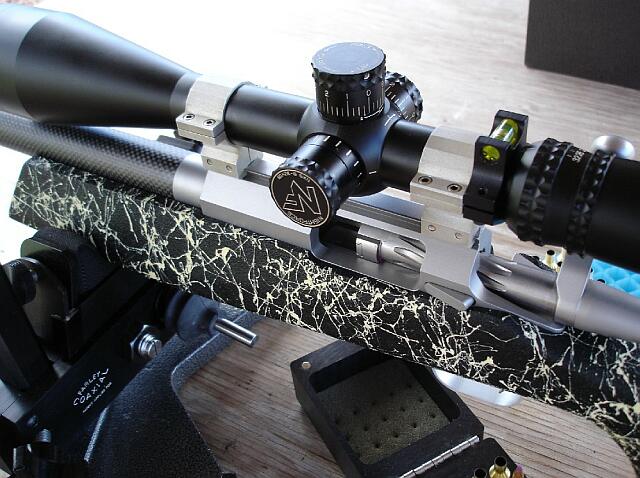
Jackal Upgrades in the Future
Now that the Jackals are completed, would I do anything different the next time? Well, there are a couple upgrades in the works. My second barrel (the all-metal one) will be carbon-wrapped and I will ask Bob Scoville to craft two carbon fiber (over balsa) stocks. That will be the ultimate. Right now, the rifle weighs ten pounds with the Zeiss on top. The pistol weighs nine pounds. With balsa-carbon stocks, we should be able reduce all-up weight by a couple of pounds or more."
BAT Bags a Buck
6mmBR.com doesn't normally run "trophy shots", but this Axis buck was so handsome, we decided to bend the rules. Plus, we wanted to demonstrate that Eric's amazing Combo Gun isn't just a Bench Queen. No, Eric built this rifle to hunt, and hunt it does. This Axis was taken during a hunt in late April of 2005, on the island of Lanai, Hawaii. Nice shootin', Eric.
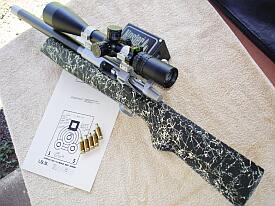 | 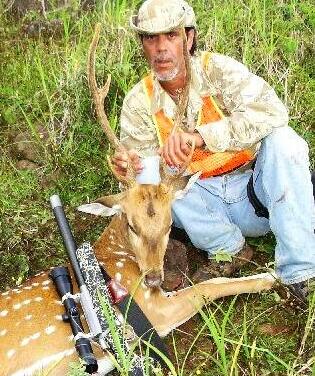 |
The SAGA of the JACKAL -- A Hunter's Tale
This all started several years back when I decided that most "semi-custom" rifles did not live up to all the marketing hype. I decided I wanted the best in quality and workmanship, with accuracy no worse than low Twos off the bench. Now get this, my dream gun also had to be compact and tough enough for hunting. As a bonus, I wanted to drop the barreled action into a pistol stock and get similar results.
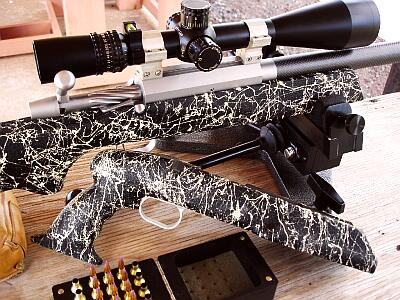 A bit of background may help explain why I decided to go with this project. I bow-hunted and shot state and local archery competition for over 20 years. I never shot with pins or any kind of bow sights or release aids. My style was and always will be split finger, and all instinctive. I used a slingshot for years as a young boy and I must say, I was pretty good. So shooting instinctively with the bow was a little easier to learn. But that was just the beginning. I had to learn and master the skills of stalking game to within 40 yards and under--the kill zone in which I felt very comfortable if I had a shot. A bit of background may help explain why I decided to go with this project. I bow-hunted and shot state and local archery competition for over 20 years. I never shot with pins or any kind of bow sights or release aids. My style was and always will be split finger, and all instinctive. I used a slingshot for years as a young boy and I must say, I was pretty good. So shooting instinctively with the bow was a little easier to learn. But that was just the beginning. I had to learn and master the skills of stalking game to within 40 yards and under--the kill zone in which I felt very comfortable if I had a shot.
My equipment and my bow were top quality and precisely tuned. Having total confidence in my equipment was paramount. I made my own strings and my own arrows. When the time came for the shot, sometimes after many hours of stalking, there was no doubt that I could make the kill. That is the confidence I had in my stuff. Without it, I might second-guess if I could make the kill and that was unacceptable. To me, if you use the best equipment out there, you can gain a lot of trust in your tools, and with that comes confidence.
Some years ago, I tore my rotator cuff and, sadly, that pretty much ended my bow-hunting days. The skill remains, but drawing the bow just hurts too much after the injury. Replacing bows with barrels, I bought several production rifles and also some semi-custom rifles and long-range pistols. One of those was a custom XP-pistol in a 7mm-08 Ackley. A disappointing hunting experience with that XP was what, ultimately, lead me to build my Jackals. Here is the story.
I was hunting (with the XP) on the Island of Lanai. I spent a couple of hours watching a big Axis buck and made my stalk to 125 yards (ranged with my Leica Geovid). That buck did not know I was there and he had two other bucks trailing him. Now I knew my XP pistol would group about an inch at 100 yards off the bench on a good day with decent technique on my part. That was the best it could do. Average was about one inch to two inches at 100 yards with my handloads. This was okay for the range and I thought it was good enough for the field.
Anyway, I had my XP resting on my pack. I had a good sight picture and touched off a shot. That buck took off like lightning and I freaked out. I had a bad feeling the shot went low, but that just didn't make sense. I knew I had held on target. I looked all over for signs of a hit and found nothing. No blood, no hair, no nothing. I walked in circles for over an hour and found nothing. Finally, I said "okay, it must have been me", even though my sight picture was flawless and my release was good after the shot. I let it go and went back to my lair and waited. Forty-five minutes later a large doe and her fawn came through the trail, same area and same thing. Awesome sight picture, clean trigger pull and release. That doe jumped straight up and bolted. I could tell it was a clean miss. The shot definitely went low. After the shot, she sprinted off, then looked back and waited for her fawn, wagged her tail and took off. That was the day I knew I would never use or buy production or "semi-custom" rigs again.
When I got back to Maui, I did some testing and found out that the scope somehow tracked three inches low and one inch left. Also after about six shots, I found the shots would string vertically. That told me there were fouling problems. At the range on Lanai, I had shot about five to seven shots before the hunt--that may have caused the drop in my shot resulting in two misses. I told my girlfriend I would sell that gun and I did two weeks later. Leupold makes some decent scopes and I am not knocking them, but for me that is where it ended.
This is why I decided to build my custom "Jackals". They would be no-compromise firearms, with the very best components. The guns would have to meet some high expectations. Come rain or shine, zero to 100 degrees, my shot must hit exactly where it was supposed to go. I wanted a gun I could count on 100%. That is the challenge I gave to my smiths and they agreed. I was not concerned about price, or delivery date, as long as quality and total reliability was the end result. I did my research and spent many, many hours on the phone, asking questions. With six years of precision hand-loading and benchrest knowledge, I wanted the ultimate rig and components. This project took over two years of planning and building and I am still upgrading this awesome rig.
|
Acknowledgements
Many individuals and companies helped with the "Jackal" project. Some very busy smiths and component-makers shared their knowledge with me at the Super Shoot, and/or patiently provided information and advice over the telephone. Even when I asked "dumb" questions, they were respectful and helpful. Without the assistance of these folks (and a few I may have overlooked), this project would not have been possible.Julie Harris (Love of my life)
Bruce Thom and BAT Machines
Speedy Gonzalez and SG&Y
Dwight Scott (Metal smith)
Tony Boyer (Still the King)
Tommy Meredith (Stocker)
Dick Wright (Precision shooting)
Don Gentner (Bullet maker) | Jim Kelbly (What a range!)
Wenig Gunstocks
John Krieger (Krieger barrels)
Nightforce Optics
Zeiss Optics
Christensen Arms (Superb carbon fiber work)
Ron Hoehn (Fantastic shooter)
Ron Sabo (Long-range pistoleer)
Jim Carstenson (JLC dies) |
Reloading Tools and Bench Gear
In closing, I would like to mention some things that are extremely important for the kind of accuracy I get with the "Jackals". I use all top of the line components in loading. You cannot get the kind of accuracy this gun delivers without using superior tools, and ultra-premium components. You need the finest actions, triggers, stocks, scopes, brass and so on. I've listed some of the equipment I used below. And you need the best gunsmiths to put it all together. The bottom line is if you want this kind of accuracy, do your homework and listen to the best. I've been fortunate that many of the best smiths, stockers, and machinists in the country helped me with this project. These men are extremely busy, and they have no time to argue or debate. But with their help (and patience), I now have total confidence in my Jackals--that's what this project was all about. When I get behind them in the field for a shot, I have absolutely no doubt that when I touch off that trigger, that shot will be true.Farley Coaxial Front Rest
Protector leather Rear Bag
Rear bag for pistol (6" brick bag)
Sinclair stainless Arbor Press
Sinclair Primer Seater
JLC stainless Micrometer Seater Die
Wilson Neck Die (custom reamed by Dwight)
Redding Neck Bushings (TiNitride coated)
K&M Deep-Angle Chamfering Tool
K&M Neck-turning Tool
Sinclair/Wilson Ultimate Case Trimmer
| Harrell's BR Powder Measure
Hoehn Case Uniformer
Starrett 6" Digital Calipers
Starrett .0001 Ball Micrometer
Custom Ogive Gauge (Dwight Scott)
Custom Neck/shoulder Gauge (Dwight Scott)
Davidson Bullet-Puller
Hood's Custom Press
Hood's Custom Gun Cradle
TK Nolland’s "Bore-Saver" Rod Guide
Dewey cleaning rods |
|
Copyright © 2005, 6mmBR.com, All Rights Reserved. No reproduction of any content without advanced permission in writing.
Topics: Hunt, Hunting, Hawaii, Maui, Lanai, Axis, Deer, 6mm, 6mm BR, 6BR, 6BR BS, BAT, B.A.T., BAT Machines, Krieger, Christensen Arms, Barrel, Carbon, IBS, NBRSA, Varminter, Varmint, Varminting, Jewell trigger, Benchrest, BR, Bench Rest, Dwight Scott, Single-shot, competition, rifle accuracy, Norma, Hodgdon Powder, H322, Varget, Vihtavuori, N150, N540, Berger, Lapua, SG&Y, Wening, stocks, BAT Action, stainless barrel, reloading, powder, case forming, Neck-turning, .262, .268, .271, No-Turn, Lapua Brass, bullets, precision.


|